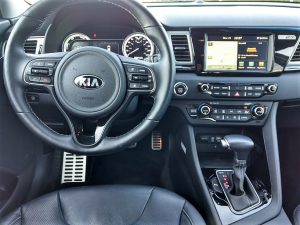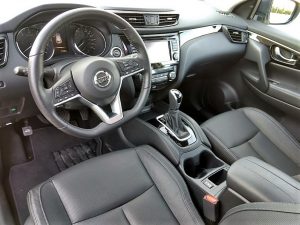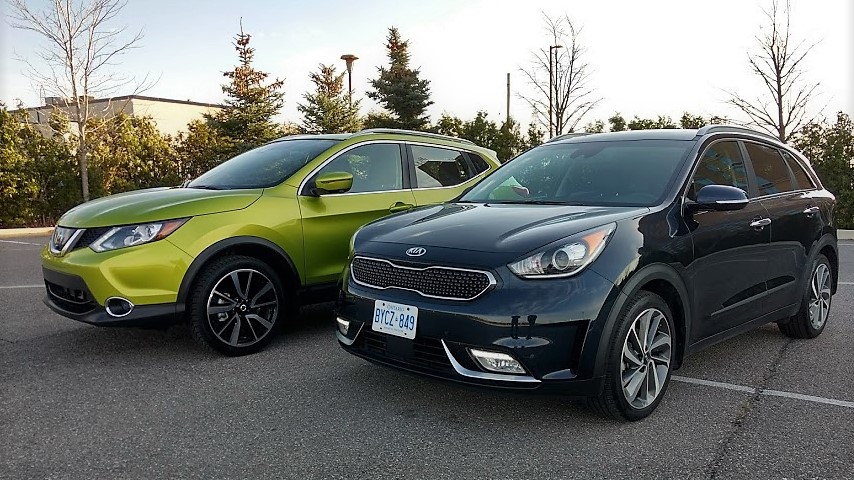By Shari Prymak
The small crossover boom has quickly resulted in a flood of different available models. A few popular options include the Honda HR-V, Subaru Crosstrek, Mazda CX-3, and, the focus of this review, the Nissan Qashqai. All of these crossovers are respectable options and accomplish more or less the same tasks. More and more automakers, however, are beginning to offer comparably-priced hybrid alternatives which retain most of the benefits of a small crossover with the added benefit of superior fuel efficiency. One such example of this is the Kia Niro. It’s time to see how a conventional crossover will fair next to one of the latest hybrid offerings.
In terms of appearance, the Niro clearly has a contemporary crossover-inspired look to it which should go over well with most shoppers. The ride height and seating position are higher than that of typical hatchbacks, but the Niro is still lower and more wagon-like than genuine crossovers like the Qashqai. The Qashqai may be a bit of a tweener as far as crossovers go, but it definitely sits on the larger end of its segment. The design is quite attractive. Kind of like a three quarter scale Nissan Rogue.
The largish dimensions of the Qashqai make it one of the more spacious subcompact crossovers on the market. The Niro’s back seats feel a little roomier than those in the Qashqai. The seatbacks can be folded flat for added practicality as well. The Qashqai has about as much passenger space as the Niro, but the cargo area definitely has a bit more room to play with.

Where the Qashqai falls behind is interior tech and design. The infotainment system and climate controls are effective and easy to use, but they look and feel dated next to the Niro’s far sleeker touchscreen interface. The interior of my top trim Qashqai SL+ Platinum test car was quite pleasant, but the Niro’s was just that much nicer.
Out on the road, the differences between the two are not as significant as one might think given the different drivetrains. Both crossovers prioritize comfort, maneuverability, and ease of use over sportiness and driver engagement. The Qashqai edges out the Niro for ride quality and overall refinement. At times, the Niro’s suspension can feel a tad too firm, and the hybrid system’s transitions between gas and electric power is not always as seamless as they could be. Being slightly lower and more buttoned-down, the Niro does have a more planted, agile feel to it when cornering.

In terms of power, the Qashqai’s 2.0L 4-cylinder engine produces 141 horsepower and 147lb-ft of torque. The Niro’s hybrid powertrain is rated for 139 horsepower and 195lb-ft of torque. Neither one offers much in the way of passing power and straight-line pace, but for errand runs and leisure commutes, both get the job done just fine. The Niro is a quieter and more refined during hard acceleration. The Qashqai, by comparison, wails and whines in protest with not a whole lot of actual forward momentum going on.
Both the Niro and Qashqai may be equally competent at typical crossover tasks, but there’s no contest when it comes to which offers superior efficiency. Over a week of mixed city and highway driving, the Niro averaged roughly 7.0L/100km. A few stop-and-go city runs yielded an even stronger 6.0L/100km, which is close to Toyota Prius level fuel economy. The Qashqai, by comparison, could only manage about 10.0L/100km in mixed city and highway driving. It’s worth noting, however, that the Niro is only available in front-wheel drive, whereas the Qashqai offers and optional all-wheel drive system. It consumes more gas because of that, but it also makes it more appealing to those who venture out of the city on a regular basis.

Hybrid vehicles have traditionally commanded a significant price premium over the equivalent gas-powered options. Depending on which trim levels you go with, however, that might not necessarily be the case with these two. The Qashqai has a starting MSRP of $19,998 for a front-wheel drive manual transmission model or $21,998 when equipped with the CVT automatic. The Niro starts at $24,995, however, you do get a few additional features which make it more comparable to the $24,598 Qashqai SV. The top end models tested here command $32,198 for the Qashqai SL+ Platinum and $32,995 for the Niro SX Touring. Again though, the Niro offers more features such as cooled front seats, heated rear seats, and a wireless smartphone charging pad.
At the end of the day, either one is a solid option for those looking for a value-packed crossover. The Qashqai stands out for its smoother ride, available all-wheel drive, and a more crossover-like feel thanks to a higher seating position and ride height. The Niro, however, offers similar crossover qualities with better cabin technology, far better fuel economy, and a stronger warranty, all without the huge hybrid price premium. It sounds like a narrow win for the Niro, but the real winner here is hybrid technology. Automakers are finally able to offer hybrid options that make sense for consumers. It’s only a matter of time before consumers take notice and become hybrid owners as well.

